24.11: Examen de Aptitud
- Page ID
- 127797
\( \newcommand{\vecs}[1]{\overset { \scriptstyle \rightharpoonup} {\mathbf{#1}} } \)
\( \newcommand{\vecd}[1]{\overset{-\!-\!\rightharpoonup}{\vphantom{a}\smash {#1}}} \)
\( \newcommand{\dsum}{\displaystyle\sum\limits} \)
\( \newcommand{\dint}{\displaystyle\int\limits} \)
\( \newcommand{\dlim}{\displaystyle\lim\limits} \)
\( \newcommand{\id}{\mathrm{id}}\) \( \newcommand{\Span}{\mathrm{span}}\)
( \newcommand{\kernel}{\mathrm{null}\,}\) \( \newcommand{\range}{\mathrm{range}\,}\)
\( \newcommand{\RealPart}{\mathrm{Re}}\) \( \newcommand{\ImaginaryPart}{\mathrm{Im}}\)
\( \newcommand{\Argument}{\mathrm{Arg}}\) \( \newcommand{\norm}[1]{\| #1 \|}\)
\( \newcommand{\inner}[2]{\langle #1, #2 \rangle}\)
\( \newcommand{\Span}{\mathrm{span}}\)
\( \newcommand{\id}{\mathrm{id}}\)
\( \newcommand{\Span}{\mathrm{span}}\)
\( \newcommand{\kernel}{\mathrm{null}\,}\)
\( \newcommand{\range}{\mathrm{range}\,}\)
\( \newcommand{\RealPart}{\mathrm{Re}}\)
\( \newcommand{\ImaginaryPart}{\mathrm{Im}}\)
\( \newcommand{\Argument}{\mathrm{Arg}}\)
\( \newcommand{\norm}[1]{\| #1 \|}\)
\( \newcommand{\inner}[2]{\langle #1, #2 \rangle}\)
\( \newcommand{\Span}{\mathrm{span}}\) \( \newcommand{\AA}{\unicode[.8,0]{x212B}}\)
\( \newcommand{\vectorA}[1]{\vec{#1}} % arrow\)
\( \newcommand{\vectorAt}[1]{\vec{\text{#1}}} % arrow\)
\( \newcommand{\vectorB}[1]{\overset { \scriptstyle \rightharpoonup} {\mathbf{#1}} } \)
\( \newcommand{\vectorC}[1]{\textbf{#1}} \)
\( \newcommand{\vectorD}[1]{\overrightarrow{#1}} \)
\( \newcommand{\vectorDt}[1]{\overrightarrow{\text{#1}}} \)
\( \newcommand{\vectE}[1]{\overset{-\!-\!\rightharpoonup}{\vphantom{a}\smash{\mathbf {#1}}}} \)
\( \newcommand{\vecs}[1]{\overset { \scriptstyle \rightharpoonup} {\mathbf{#1}} } \)
\( \newcommand{\vecd}[1]{\overset{-\!-\!\rightharpoonup}{\vphantom{a}\smash {#1}}} \)
\(\newcommand{\avec}{\mathbf a}\) \(\newcommand{\bvec}{\mathbf b}\) \(\newcommand{\cvec}{\mathbf c}\) \(\newcommand{\dvec}{\mathbf d}\) \(\newcommand{\dtil}{\widetilde{\mathbf d}}\) \(\newcommand{\evec}{\mathbf e}\) \(\newcommand{\fvec}{\mathbf f}\) \(\newcommand{\nvec}{\mathbf n}\) \(\newcommand{\pvec}{\mathbf p}\) \(\newcommand{\qvec}{\mathbf q}\) \(\newcommand{\svec}{\mathbf s}\) \(\newcommand{\tvec}{\mathbf t}\) \(\newcommand{\uvec}{\mathbf u}\) \(\newcommand{\vvec}{\mathbf v}\) \(\newcommand{\wvec}{\mathbf w}\) \(\newcommand{\xvec}{\mathbf x}\) \(\newcommand{\yvec}{\mathbf y}\) \(\newcommand{\zvec}{\mathbf z}\) \(\newcommand{\rvec}{\mathbf r}\) \(\newcommand{\mvec}{\mathbf m}\) \(\newcommand{\zerovec}{\mathbf 0}\) \(\newcommand{\onevec}{\mathbf 1}\) \(\newcommand{\real}{\mathbb R}\) \(\newcommand{\twovec}[2]{\left[\begin{array}{r}#1 \\ #2 \end{array}\right]}\) \(\newcommand{\ctwovec}[2]{\left[\begin{array}{c}#1 \\ #2 \end{array}\right]}\) \(\newcommand{\threevec}[3]{\left[\begin{array}{r}#1 \\ #2 \\ #3 \end{array}\right]}\) \(\newcommand{\cthreevec}[3]{\left[\begin{array}{c}#1 \\ #2 \\ #3 \end{array}\right]}\) \(\newcommand{\fourvec}[4]{\left[\begin{array}{r}#1 \\ #2 \\ #3 \\ #4 \end{array}\right]}\) \(\newcommand{\cfourvec}[4]{\left[\begin{array}{c}#1 \\ #2 \\ #3 \\ #4 \end{array}\right]}\) \(\newcommand{\fivevec}[5]{\left[\begin{array}{r}#1 \\ #2 \\ #3 \\ #4 \\ #5 \\ \end{array}\right]}\) \(\newcommand{\cfivevec}[5]{\left[\begin{array}{c}#1 \\ #2 \\ #3 \\ #4 \\ #5 \\ \end{array}\right]}\) \(\newcommand{\mattwo}[4]{\left[\begin{array}{rr}#1 \amp #2 \\ #3 \amp #4 \\ \end{array}\right]}\) \(\newcommand{\laspan}[1]{\text{Span}\{#1\}}\) \(\newcommand{\bcal}{\cal B}\) \(\newcommand{\ccal}{\cal C}\) \(\newcommand{\scal}{\cal S}\) \(\newcommand{\wcal}{\cal W}\) \(\newcommand{\ecal}{\cal E}\) \(\newcommand{\coords}[2]{\left\{#1\right\}_{#2}}\) \(\newcommand{\gray}[1]{\color{gray}{#1}}\) \(\newcommand{\lgray}[1]{\color{lightgray}{#1}}\) \(\newcommand{\rank}{\operatorname{rank}}\) \(\newcommand{\row}{\text{Row}}\) \(\newcommand{\col}{\text{Col}}\) \(\renewcommand{\row}{\text{Row}}\) \(\newcommand{\nul}{\text{Nul}}\) \(\newcommand{\var}{\text{Var}}\) \(\newcommand{\corr}{\text{corr}}\) \(\newcommand{\len}[1]{\left|#1\right|}\) \(\newcommand{\bbar}{\overline{\bvec}}\) \(\newcommand{\bhat}{\widehat{\bvec}}\) \(\newcommand{\bperp}{\bvec^\perp}\) \(\newcommand{\xhat}{\widehat{\xvec}}\) \(\newcommand{\vhat}{\widehat{\vvec}}\) \(\newcommand{\uhat}{\widehat{\uvec}}\) \(\newcommand{\what}{\widehat{\wvec}}\) \(\newcommand{\Sighat}{\widehat{\Sigma}}\) \(\newcommand{\lt}{<}\) \(\newcommand{\gt}{>}\) \(\newcommand{\amp}{&}\) \(\definecolor{fillinmathshade}{gray}{0.9}\)Examen de competencia
Para las ecuaciones cuadráticas en los siguientes problemas, especifique los valores de\(a, b\), y\(c\).
\(2y^2 - 3y + 10 = 0\)
- Contestar
-
\(a=2,b=−3,c=10\)
\(10b^2 = 3b\)
- Contestar
-
\(a=10,b=−3,c=0\)
Para los siguientes problemas, utilice la propiedad de factor cero para resolver cada ecuación cuadrática.
\((3x+5)(x−1)=0\)
- Contestar
-
\(x = -\dfrac{5}{3}, 1\)
\(3b(2b−1)=0\)
- Contestar
-
\(b = 0, \dfrac{1}{2}\)
\((a - 8)^2 = 0\)
- Contestar
-
\(a=8\)
Para los siguientes problemas, resolver cada ecuación cuadrática por factorización.
\(4x^2 - 16 = 0\)
- Contestar
-
\(x=−2,2\)
\(y^2 - 12y + 32 = 0\)
- Contestar
-
\(y=4,8\)
\(a^2 - 5a = 14\)
- Contestar
-
\(−2,7\)
\(6a^2 = 10 - 11a\)
- Contestar
-
\(a = -\dfrac{5}{2}, \dfrac{2}{3}\)
\(2x^2 = -2 - 5x\)
- Contestar
-
\(x = -2, -\dfrac{1}{2}\)
\(x^3 - 25x = 0\)
- Contestar
-
\(x=0,−5,5\)
Para los siguientes problemas, resolver cada ecuación cuadrática mediante extracción de raíces.
\(c^2 = 81\)
- Contestar
-
\(c=−9,9\)
\(x^2 = 15\)
- Contestar
-
\(x = -\sqrt{15}, \sqrt{15}\)
\(3a^2 - 18 = 0\)
- Contestar
-
\(a = -\sqrt{6}, \sqrt{6}\)
\((x - 5)^2 = 1\)
- Contestar
-
\(x=4,6\)
\((y + 11)^2 - 9 = 0\)
- Contestar
-
\(y=−8,−14\)
\(y^2 - 25z^2 = 0\)para\(y\).
- Contestar
-
\(y=−5z,5z\)
\(6a^2 - 18b^2c^2\)para\(a\)
- Contestar
-
\(a = \pm bc\sqrt{3}\)
Para los siguientes problemas, resuelve cada ecuación cuadrática usando la fórmula cuadrática.
\(x^2 - 6x - 16 = 0\)
- Contestar
-
\(x=−2,8\)
\(y^2 - 2y - 7 = 0\)
- Contestar
-
\(y = 1 + 2\sqrt{2}\)
\((m + 2)^2 - 5 = 0\)
- Contestar
-
\(m = -2 \pm \sqrt{5}\)
\((x + b)^2 = c^2\)
- Contestar
-
\(x = -b \pm c\)
\((x+1)(x+4)=6\)
- Contestar
-
\(x = \dfrac{-5 \pm \sqrt{33}}{2}\)
\(5z^2 - 5z - 5 = 2z^2 - z\)
- Contestar
-
\(z = \dfrac{2 \pm \sqrt{19}}{3}\)
\(2m^2 = 5m\)
- Contestar
-
\(m = 0, \dfrac{5}{2}\)
Para los siguientes problemas, resuelve cada ecuación cuadrática completando el cuadrado.
\(x^2 + 6x - 8 = 0\)
- Contestar
-
\(x = -3 \pm \sqrt{17}\)
\(2x^2 + 7x - 12 = 0\)
- Contestar
-
\(x = \dfrac{-7 \pm \sqrt{145}}{4}\)
El producto de dos enteros impares consecutivos es 143. ¿Qué son?
- Contestar
-
11 y 13 o −11 y −13
Un estudio de la calidad del aire realizado por un grupo ambiental sugiere que dentro de t años el nivel de monóxido de carbono en el aire, en partes por millón, estará dado por la ecuación cuadrática
\(A = 0.4t^2 + 0.1t + 3.1\)
donde\(A\) representa la cantidad de monóxido de carbono en el aire.
a) ¿Cuál es el nivel, en partes por millón, de monóxido de carbono en el aire ahora?
b) ¿Cuántos años a partir de ahora estará el nivel de monóxido de carbono en 18.1 partes por millón?
- Contestar
-
a) 3.1
b) dentro de 6 años
El largo de un rectángulo es 6 pulgadas más largo que el ancho del rectángulo. Encuentra las dimensiones del rectángulo si el área es de 112 pies cuadrados.
- Contestar
-
ancho:\(\dfrac{-1 + \sqrt{1793}}{4}\)
longitud:\(\dfrac{1 + \sqrt{1793}}{4}\)
Para los siguientes problemas, construya las gráficas de las siguientes ecuaciones.
\(y = x^2 - 3\)

- Contestar
-
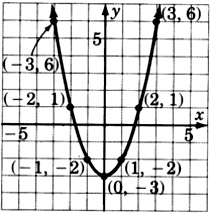
\(y = (x + 1)^2\)

- Contestar
-
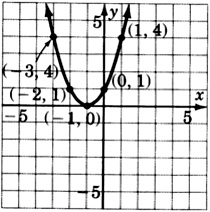
\(y = (x-2)^2 + 3\)

- Contestar
-
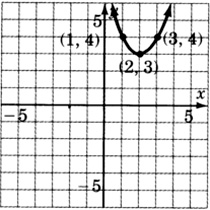
Para los siguientes problemas, escriba la ecuación que corresponda a cada gráfica.
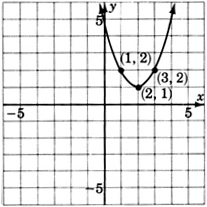
- Contestar
-
\(y = (x-2)^2 + 1\)o\(y = x^2 - 4x + 5\)
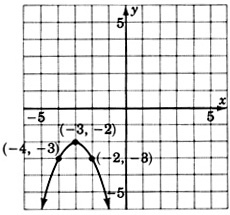
- Contestar
-
\(y = -(x + 3)^2 - 2\)o\(y = -x^2 - 6x - 11\)


